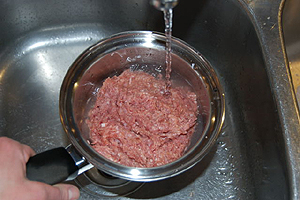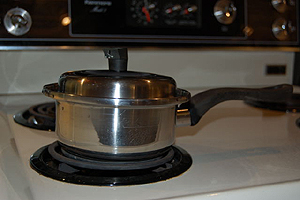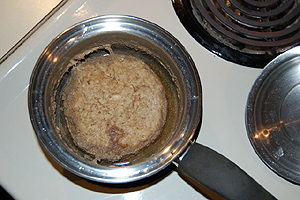You will discover the true benefit of feeding a homemade diet when feeding the meat to your cat raw. The nutrients in raw meat are not de-natured by harmful heat. Many vitamins don’t survive heating, and most molecular structure of proteins and fatty acids change when heated. Heat breaks molecular bonds, and essential long chain amino acid or fatty acids can be lost. Beyond that, raw meat is the most appropriate and natural source of beneficial and essential gut microbes for the cat.
However, before you abandon the whole idea of homemade cat food because you do not want to feed raw meat to your cat at this point I want to say that making a homemade cat food using cooked meat is much better than not doing it at all. How to cook the meat will be discussed here. Refer back to the cat food recipe page or the instructions of the premix to finish making the cat food.
A discomfort with the thought of feeding meat raw is natural, as are concerns about germs. After feeding my cats with raw meat and teaching people to do the same for over two decades, however, I can assure you that there is no more risk to feeding cats raw meat than there is to feeding cats dry cat food! If your cat has a specific health concern that requires the food to be sterilized, or you need need more time to warm up to the idea of feeding meat raw, here are my suggestions on how to prepare cat food using cooked meat.
Pictorial Preparation Instructions:
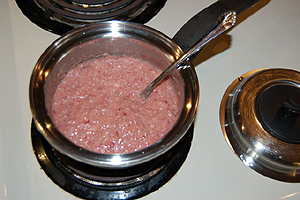 |
2. Place the required amount of meat, as outlined in your preparation instructions or recipe, in a pot and add enough water to create a stew-like consistency. |
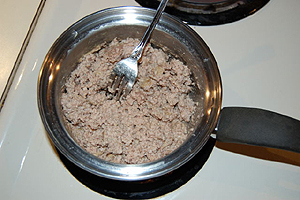 |
5. Break the meat “cake” apart with a fork and mix the broth back into the meat. |
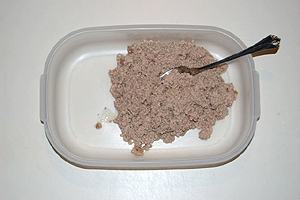 |
6. Allow to cool to room temperature before adding the cooked meat to the cat food premix or combining the cooked meat with the other ingredients outlined in the cat food recipe. |
It is important to allow the cooked meat to cool to at least body temperature before adding the TCfeline cat food premix or before adding the other ingredients of the cat food recipe to it. Mixing the other ingredients or the premix with hot meat might damage their nutritional value. Make sure not to burn the meat. If you have burned the meat, throw it out and start fresh. Unless you forget about the pot on your stove top, this method should not burn the meat. Do not add oil to the meat or the pot to prevent it from sticking. We do not want to fry the meat! Cooked meat does not freeze as nicely as raw meat does. It is my suggestion to cut the preparation instructions or recipe in half (or less) and forgo freezing the food altogether. Cooked meat is more stable in the refrigerator than raw meat, and can be stored there for up to four days. If you are using a premix or recipe that calls for liver, puree or grind the fresh liver and add it to your meat before cooking. The vitamin A (retinol) and Vitamin D in liver are stable at normal cooking temperatures.
It is necessary to mention that my feeding trials are entirely based on feeding meat raw and that I possess no data on the long term effects on feeding cats with my recipe or premix in combination with cooked meat.
